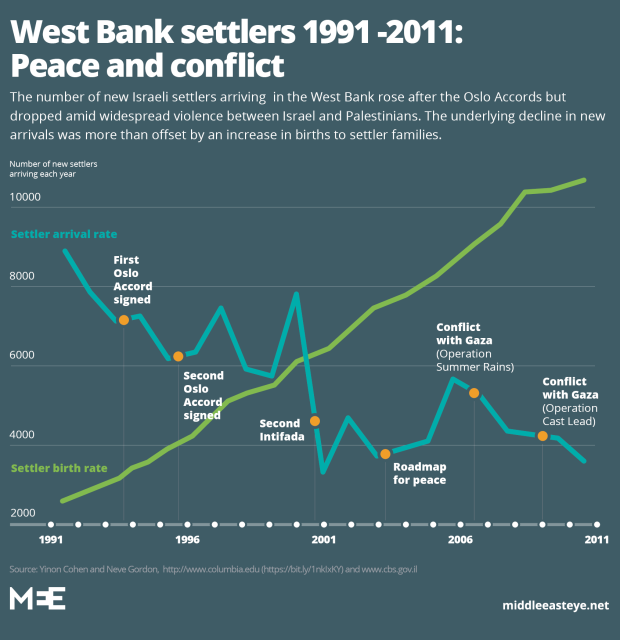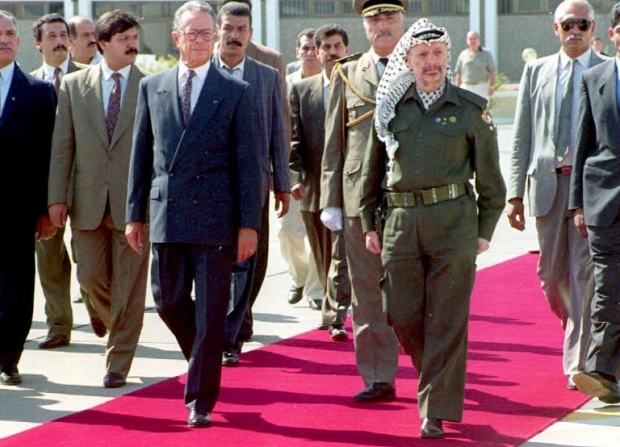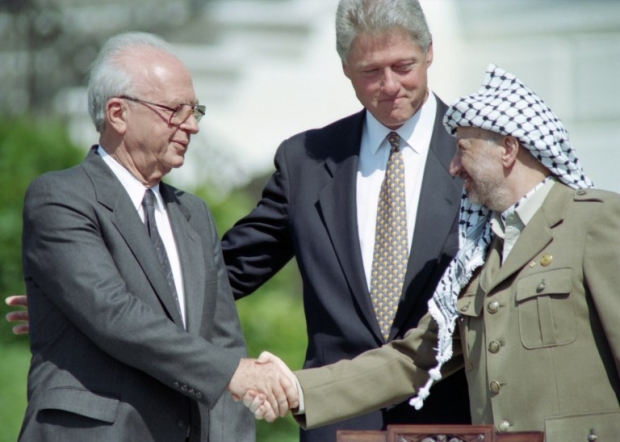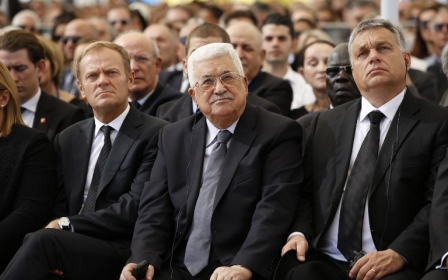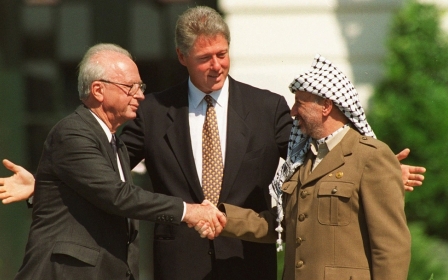A 'gentleman's agreement': How Israel got what it wanted from Oslo
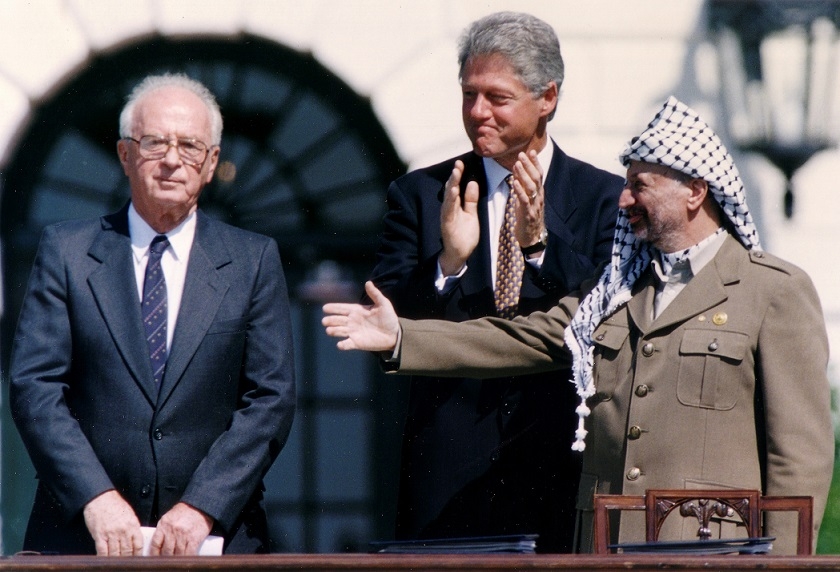
There will be no anniversary celebrations this week to mark the signing of the Oslo Accords in Washington 25 years ago. It is a silver jubilee for which there will be no street parties, no commemorative mugs, no specially minted coins.
Oslo never died. It is still doing today exactly what it was set up to do
- Diana Buttu, Palestinian lawyer and former PA adviser
Palestinians have all but ignored the landmark anniversary, while Israel’s commemoration has amounted to little more than a handful of doleful articles in the Israeli press about what went wrong.
The most significant event has been a documentary, The Oslo Diaries, aired on Israeli TV and scheduled for broadcast in the US this week. It charts the events surrounding the creation of the peace accords, signed by Palestinian leader Yasser Arafat and Israeli Prime Minister Yitzhak Rabin in Washington on 13 September 1993.
The euphoria generated by the Norwegian-initiated peace process a quarter of a century ago now seems wildly misplaced to most observers. The promised, phased withdrawals by Israel from the occupied Palestinian territories got stuck at an early stage.
And the powers of the Palestinian Authority, a Palestinian government-in-waiting that came out of Oslo, never rose above managing healthcare and collecting garbage in densely populated Palestinian areas, while coordinating with Israel on security matters.
All the current efforts to draw lessons from these developments have reached the same conclusion: that Oslo was a missed opportunity for peace, that the accords were never properly implemented, and that the negotiations were killed off by Palestinian and Israeli extremists.
Occupation reorganised
But analysts Middle East Eye has spoken to take a very different view.
“It is wrong to think of Oslo being derailed, or trying to identify the moment the Oslo process died,” says Diana Buttu, a Palestinian lawyer and former adviser to the Palestinian Authority. “Oslo never died. It is still doing today exactly what it was set up to do.”
Michel Warschawski, an Israeli peace activist who developed strong ties with Palestinian leaders in the Oslo years, concurred.
“I and pretty much everyone else I knew at that time was taken in by the hype that the occupation was about to end. But in reality, Oslo was about reorganising the occupation, not ending it. It created a new division of labour.
“Rabin didn’t care much about whether the Palestinians got some indicators of sovereignty – a flag and maybe even a seat at the United Nations.
“But Israel was determined to continue controlling the borders, the Palestinians’ resources, the Palestinian economy. Oslo changed the division of labour by sub-contracting the hard part of Israel’s security to the Palestinians themselves.”
The accords were signed in the immediate aftermath of several years of a Palestinian uprising in the occupied territories – the First Intifada – that had proved costly to Israel, both in terms of casualties and treasure.
Under Oslo, Palestinian security forces patrolled the streets of Palestinian cities, overseen by and in close coordination with the Israeli military. The tab, meanwhile, was picked up by Europe and Washington.
In an interview with the Haaretz newspaper last week, Joel Singer, the Israeli government lawyer who helped to draft the accords, conceded as much. Rabin, he said, “thought it would enhance [Israeli] security to have the Palestinians as the ones fighting Hamas”.
That way, as Rabin once observed, the occupation would no longer be accountable to the “bleeding hearts” of the Israeli supreme court and Israel’s active human rights community.
Less than statehood
The widespread assumption that Oslo would lead to a Palestinian state was also mistaken, Buttu says.
She notes that nowhere in the accords was there mention of the occupation, a Palestinian state, or freedom for the Palestinians. And no action was specified against Israel’s illegal settlements – the chief obstacle to Palestinian statehood.
Instead, the stated goal of the Oslo process was implementation of two outstanding United Nations resolutions – 242 and 338. The first concerned the withdrawal of the Israeli army from “territories” occupied in the 1967 war, while the second urged negotiations leading to a “just and durable peace”.
“I spoke to both Arafat and Mahmoud Abbas [his successor as Palestinian president] about this,” said Buttu. “Their view was that clearer language, on Palestinian statehood and independence, would never have got past Rabin’s coalition.
“So Arafat treated resolutions 242 and 338 as code words. The Palestinian leadership referred to Oslo as a ‘gentlemen’s agreement’. Their approach was beyond naïve; it was reckless. They behaved like amateurs.”
Asad Ghanem, a politics professor at Haifa University and expert on Palestinian nationalism, said the Palestinian leadership was aware from the outset that Israel was not offering real statehood.“In his memoirs, Ahmed Qurei [one of the key architects of Oslo on the Palestinian side] admitted his shock when he started meetings with the Israeli team,” says Ghanem.
“Uri Savir [Israel’s chief negotiator] said outright that Israel did not favour a Palestinian state, and that something less was being offered. The Israelis’ attitude was ‘Take it or leave it’.”
Sympathy with settlers
All the analysts agreed that a lack of good faith on Israel’s part was starkly evident from the start, especially over the issue of the settlements.
Noticeably, rather than halt or reverse the expansion of the settlements during the supposed five-year transition period, Oslo allowed the settler population to grow at a dramatically accelerated rate.
The near-doubling of settler numbers in the West Bank and Gaza to 200,000 by the late 1990s was explained by Alan Baker, a legal adviser to Israel’s foreign ministry after 1996 and a settler himself, in an interview in 2003.
Most of the settlements were portrayed to the Israeli public as Israeli “blocs”, outside the control of the newly created PA. With the signing of the accords, Baker said, “we are no longer an occupying power, but we are instead present in the territories with their [the Palestinians’] consent and subject to the outcome of negotiations.”
Recent interviews with settler leaders by Haaretz hint too at the ideological sympathy between Rabin’s supposedly leftist government and the settler movement.
Referring to settlements that most had assumed would be dismantled under the accords, Harel noted: “When [Hever] was accused [by other settlers] of cooperating, he would say he saved us from disaster. They [the Israeli army] marked areas that could have isolated settlements and made them disappear.”
Israel’s Oslo lawyer, Joel Singer, confirmed the Israeli leadership’s reluctance to address the issue of the settlements.
“We fought with the Palestinians, on Rabin and [Shimon] Peres’ orders, against a [settlement] freeze,” he told Haaretz. “It was a serious mistake to permit the settlements to continue to race ahead.”
Rabin’s refusal to act
Neve Gordon, a politics professor at Ben Gurion University in Israel’s south, says the critical test of Rabin’s will to tackle the settlements came less than a year into the Oslo process. It was then that Baruch Goldstein, a settler, killed and wounded more than 150 Palestinians at worship in the Palestinian city of Hebron.
“That gave Rabin the chance to remove the 400 extremist settlers who were embedded in the centre of Hebron,” Gordon told MEE. “But he didn’t act. He let them stay.”
Warschawski says Rabin could have dismantled the settlements if he had acted quickly. “The settlers were in disarray in the early stages of Oslo, but he didn’t move against them.”
After Rabin’s assassination in late 1995, his successor Shimon Peres, also widely identified as an architect of the Oslo process, changed tactics, according to Warschawski. “Peres preferred to emphasise internal reconciliation [between Israelis], rather than reconciliation with the Palestinians. After that, the religious narrative of the extremist settlers came to dominate.”
That would lead a few months later to the electoral triumph of the right under Benjamin Netanyahu.
The demographic differential
Although Netanyahu campaigned vociferously against the Oslo Accords, they proved perfect for his kind of rejectionist politics, says Gordon.
Under cover of vague promises about Palestinian statehood, “Israel was able to bolster the settlement project,” in Gordon’s view. “The statistics show that, when there are negotiations, the demographic growth of the settler population in the West Bank increases. The settlements get rapidly bigger. And when there is an intifada, they slow down.
“So Oslo was ideal for Israel’s colonial project.”
It was not only that, under the pressure of Oslo, religious settlers ran to “grab the hilltops”, as a famous army general and later prime minister, Ariel Sharon, put it. Gordon pointed to a strategy by the government of recruiting a new type of settler during the initial Oslo years.In the early 1990s, after the fall of the Soviet Union, Sharon and others had tried to locate Russian-speaking new immigrants in large settlements like Ariel, in the central West Bank. “The problem was that many of the Russians had only one child,” says Gordon.
Israel was able to bolster the settlement project... Oslo was ideal for Israel's colonial project
- Neve Gordon, politics professor at Ben Gurion University
So instead, Israel began moving the ultra-Orthodox into the occupied territories. These fundamentalist religious Jews, Israel’s poorest community, typically have seven or eight children. They were desperate for housing solutions, noted Gordon, and the government readily provided incentives to lure them into two new ultra-Orthodox settlements, Modiin Ilit and Beitar Illit.
“After that, Israel didn’t need to recruit lots of new settlers,” Gordon says. “It just needed to buy time with the Oslo process and the settler population would grow of its own accord.
“The ultra-Orthodox became Israel’s chief demographic weapon. In the West Bank, Jewish settlers have on average two more children than Palestinians – that demographic differential has an enormous impact over time.”
Palestinian dependency
Buttu pointed to another indicator of how Israel never intended the Oslo Accords to lead to a Palestinian state. Shortly before Oslo, from 1991 onwards, Israel introduced much more severe restrictions on movement, including an increasingly sophisticated permit system.
“Movement from Gaza to the West Bank became possible only in essential cases,” she says. “It stopped being a right.”
That process, Ghanem noted, has been entrenched over the past quarter century, and ultimately led to a complete physical and ideological separation between Gaza and the West Bank, now ruled respectively by Hamas and Abbas’s Fatah.
Gordon observed that Oslo’s economic arrangements, governed by the 1995 Paris Protocol, stripped the Palestinians of financial autonomy too.
“The Palestinians did not get their own currency, they had to use the Israeli shekel. And a customs union made the Palestinians a dependent market for Israeli goods and empowered Israel to collect import duties on behalf of the PA. Refusing to transfer that money was a stick Israel has regularly wielded against the Palestinians.”
According to the analysts, those Palestinian leaders like Arafat who were allowed by the Oslo process to return from exile in Tunisia – sometimes referred to as the “outsiders” – were completely ignorant of the situation on the ground.
“They were bright and well-educated, but they were clueless about what was happening on the ground. They had no idea what demands to make of Israel,” he says.
“Israel, on the other hand, had experts who knew the situation intimately.”
Warschawski has similar recollections. He took a senior Palestinian recently arrived from Tunis on a tour of the settlements. The official sat in his car in stunned silence for the whole journey.
“They knew the numbers but they had no idea how deeply entrenched the settlements were, how integrated they were into Israeli society,” he says. “It was then that they started to understand the logic of the settlements for the first time, and appreciate what Israel’s real intentions were.”
Lured into a trap
Warschawski noted that the only person in his circle who rejected the hype around the Oslo Accords from the very beginning was Matti Peled, a general turned peace activist who knew Rabin well.
“When we met for discussions about the Oslo Accords, Matti laughed at us. He said there would be no Oslo, there would be no process that would lead to peace.”
They couldn’t move forward towards statehood because Israel blocked their way. But equally, they couldn’t back away from the peace process either
- Asad Ghanem, politics professor at Haifa University
Ghanem says the Palestinian leadership eventually realised that they had been lured into a trap.
“They couldn’t move forward towards statehood, because Israel blocked their way,” he says. “But equally, they couldn’t back away from the peace process either. They didn’t dare dismantle the PA, and so Israel came to control Palestinian politics.
“If Abbas leaves, someone else will take over the PA and its role will continue.”
Why did the Palestinian leadership enter the Oslo process without taking greater precautions?
According to Buttu, Arafat had reasons to feel insecure about being outside Palestine, along with other PLO leaders living in exile in Tunisia, in ways that he hoped Oslo would solve.
“He wanted a foot back in Palestine,” she says. “He felt very threatened by the ‘inside’ leadership, even though they were loyal to him. The First Intifada had shown they could lead an uprising and mobilise the people without him.
“He also craved international recognition and legitimacy.”
Trench warfare
According to Gordon, Arafat believed he would eventually be able to win concessions from Israel.
“He viewed it as trench warfare. Once he was in historic Palestine, he would move forward trench by trench.”
Warschawski noted that Arafat and other Palestinian leaders had told him they believed they would have significant leverage over Israel.
“Their view was that Israel would end the occupation in exchange for normalisation with the Arab world. Arafat saw himself as the bridge that would provide the recognition Israel wanted. His attitude was that Rabin would have to kiss his hand in return for such an important achievement.
“He was wrong.”
The “peace dividend”, however, was challenged by an equally appealing “war dividend”.
“Even before 9/11, Israel’s expertise in the realms of security and technology proved profitable. Israel realised there was lots of money to be made in fighting terror.”
In fact, Israel managed to take advantage of both the peace and war dividends.
Thanks to Oslo, Israel became normalised in the region, while paradoxically the Palestinians found themselves transformed into the foreign object
- Diana Buttu, Palestinian lawyer and former PA adviser
Buttu noted that more than 30 countries, including Morocco and Oman, developed diplomatic or economic relations with Israel as a result of the Oslo Accords. The Arab states relented on their boycott and anti-normalisation policies, and major foreign corporations no longer feared being penalised by the Arab world for trading with Israel.
“Israel’s peace treaty with Jordan [in 1994] could never have happened without Oslo,” she says.
“Instead of clear denunciations of the occupation, the Palestinians were saddled with the language of negotiations and compromises for peace.
“The Palestinians became a charity case, seeking handouts from the Arab world so that the PA could help with the maintenance of the occupation rather than leading the resistance.
“Thanks to Oslo, Israel became normalised in the region, while paradoxically the Palestinians found themselves transformed into the foreign object.”
This article is available in French on Middle East Eye French edition.
New MEE newsletter: Jerusalem Dispatch
Sign up to get the latest insights and analysis on Israel-Palestine, alongside Turkey Unpacked and other MEE newsletters
Middle East Eye delivers independent and unrivalled coverage and analysis of the Middle East, North Africa and beyond. To learn more about republishing this content and the associated fees, please fill out this form. More about MEE can be found here.





